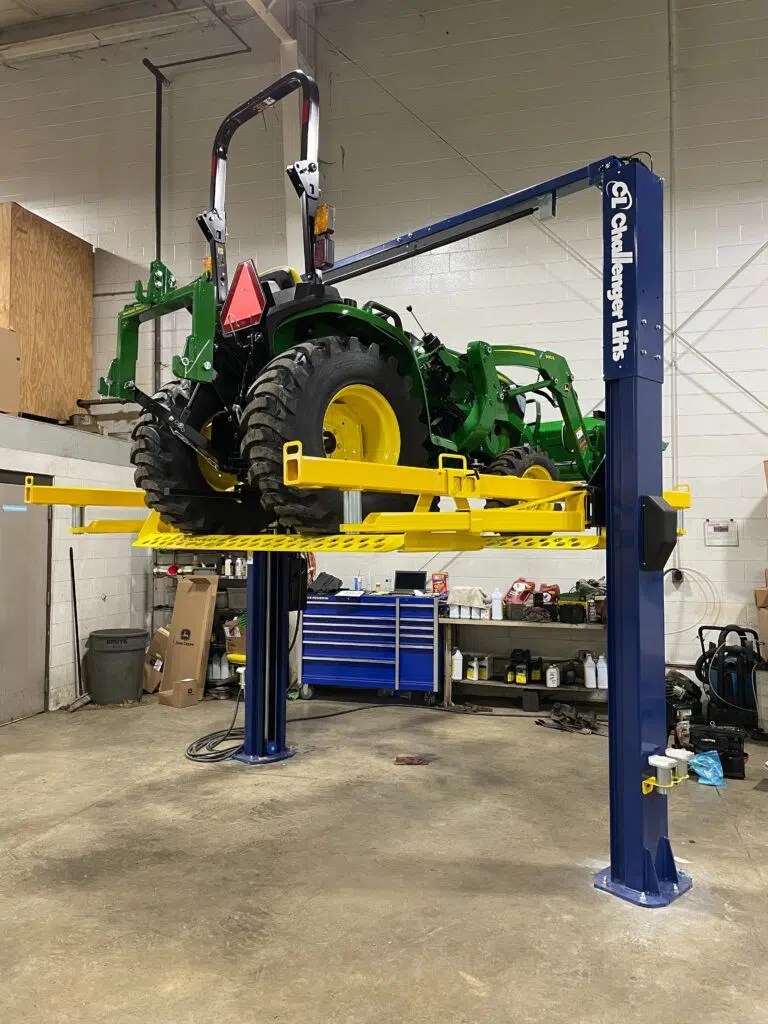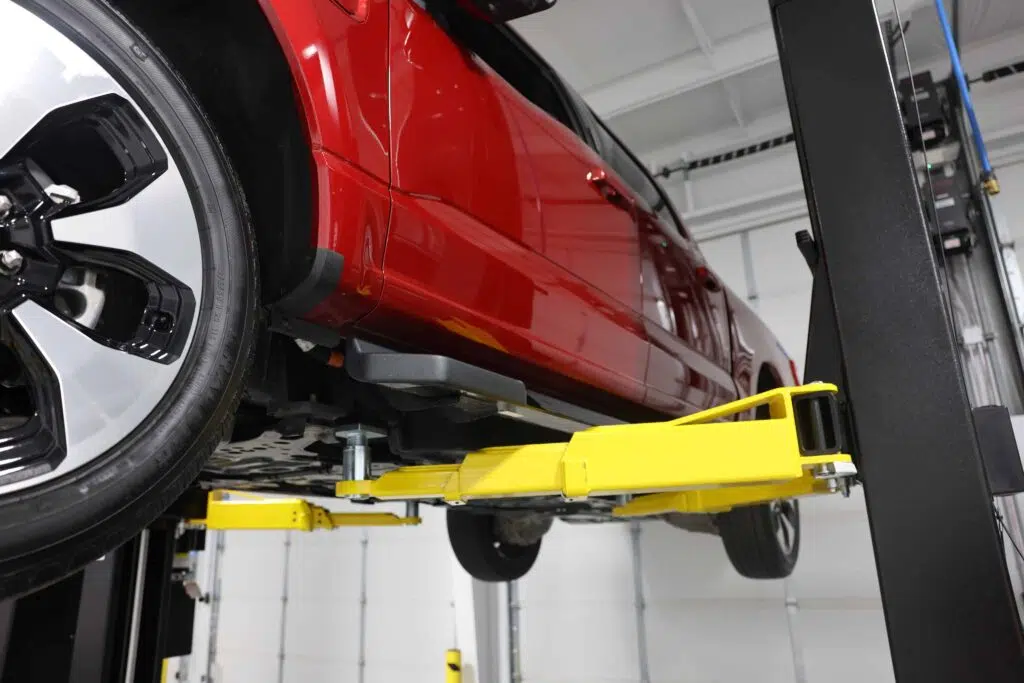Choosing the Right 2-Post Lift for Your Shop or Garage
So, you’re considering purchasing a vehicle lift. Are you in the early stages of learning about hydraulic lift options for vehicles? All the types and terminology can be confusing. Do you want an in-ground lift? An above-ground lift? How much should it be able to lift? Should it have a floor plate or a clear floor? What does asymmetrical mean?
Well, it’s not a huge surprise to learn that different lifts serve different purposes. Choosing the right one? That ensures the highest standards for safety, efficiency, and durability. Today, let’s break down all the information about one of the most popular options, 2 post vehicle lifts. By the end of this article, you should be confident in your ability to make the best 2-post lift choice for your needs.

What’s a 2-Post Lift?
It may seem obvious, but for the record, a 2-post car lift or hoist is a tool you use to lift a vehicle in the air. A two post vehicle lift uses hydraulic pressure to hoist the vehicle above the ground. It lifts the car from swing arms and lift pads placed beneath the car at points approved by the vehicle’s manufacture. You can use two-post lifts for maintenance or storage. Mechanics use two-post lifts to get at the vehicle’s underside. This also prevents them from having to stoop over or use a wheeled mechanic’s creeper.
A lift or hoist prevents many backaches for people who work on cars. It’s true whether they’re a professional wrencher or a weekend warrior in their home garage. Many people and businesses buy a two post lift because they are affordable. What’s more, they also don’t take up a lot of shop space. You can lift most kinds of vehicles with a two-post lift, depending on their weight. Given these features, it’s no surprise so many people choose a two-post lift for their needs.

How Does a 2-Post Lift Work?
There are two-post lifts called “wheel contact drive-on lifts” with a ramp you drive the car onto. Today, though, we’re going to talk about frame contact lifts.
Installers mount a frame contact two-post lift to a concrete floor. An electric motor uses hydraulic fluid power to move the lift arms up and down. The wiring and other important elements of the lift cross the vehicle. This occurs either under it, through a floor plate, or above it in an overhead beam. Hydraulic cylinders inside the posts connect to a hydraulic pump via fluid lines. An equilibrium cable keeps the lift arms moving in synchronization.
Support Arms
Frame contact 2 post lifts use adjustable lift arms to make contact with the frame of the vehicle. Different vehicles have different lift points. Manufacturers mark these points with decals, holes, or depressions at each lift point. Consult the vehicle’s manual to ensure you have the correct lifting points. You can also consult vehicle lift point guides from the American Lift Institute.
You may need rubber pads or different adapters based on what kind of vehicle you are trying to lift. These adapters include metal pieces with screw threads. They are adjustable for different heights between the lift points on the vehicle. You must keep the pads or adapters for lift arms clean and grease-free to prevent slippage.

Proper Installation
Many people ask us about the concrete requirements for installing a two-post lift. There are different requirements for different lifts, based on the lift’s weight capacity. An adequately thick concrete slab helps support the weight of the vehicle as it is hoisted into the air.
The minimum concrete thickness for any vehicle lift is 4 to 4.5 inches with a compression strength of 3,000 PSI. This will be adequate for 2-post lifts with a capacity of up to 10,000 pounds. For higher-capacity two post lifts, you will need a concrete thickness of 6 inches. You should imbed the anchor bolts in the concrete at least 3.25 inches deep.
Understanding Vehicle Center of Gravity
The kind of two post vehicle lift you need depends on the vehicle’s center of gravity. A symmetrical two-post lift is ideal for vehicles with even weight distribution from the front to the back of the vehicle.
There are vehicles that are heavier in the front. This includes front-wheel-drive vehicles and some EVs. A 2-post hoist with symmetrical lift arms will not be suitable for these vehicles. Instead, you will need a two post lift with asymmetrical arms, or one that is adjustable to do both.
Why Balance Matters When Lifting a Car or Truck
When using a 2-post lift, balance is everything. If a vehicle is off-balance, it can shift or even fall. That’s dangerous for both the vehicle and the people working around it.
The arms of the lift need to support the weight of the car or truck correctly. That’s why it’s important to know whether your vehicle is heavier in the front, the back, or balanced overall.
Improper positioning, like putting the arms in the wrong spot or using the wrong type of lift, can lead to instability. The vehicle may rock, tip, or not lift evenly, which increases the risk of accidents or damage.
Best Practices for a Safe Lift:
- Always follow the lift manufacturer’s guidelines.
- Use the correct lifting points (these can vary by vehicle).
- Make sure the vehicle is centered between the posts.
- Double-check that the arms are locked and secure before lifting.
- If you’re ever unsure, stop and check. Safety comes first.
Different Kinds of 2-Post Lifts
Overhead vs. Base Plate
Overhead Lifts
These lifts have a bar across the top that connects both posts.
- The hydraulic lines and cables run overhead.
- This gives you more floor space between the posts. This is great for tall vehicles or when you need to roll equipment under the car.
- It’s a good option if your garage or shop has a high ceiling.
Base Plate Lifts:
These lifts have a plate that runs along the floor between the two posts.
- The hydraulic lines and cables run under the vehicle, inside the plate.
- This type is ideal for shops or garages with low ceilings, where an overhead bar wouldn’t fit.
- Just make sure the plate doesn’t get in the way of rolling equipment like toolboxes or jacks.
Both overhead and base plate lifts do the same job. They just route their cables differently depending on your space.
Symmetrical vs. Asymmetrical vs. Versymmetric®
- Symmetrical Lifts:
- Equal-length arms and evenly spaced columns.
- Best for larger, evenly balanced vehicles (trucks, vans).
- Asymmetrical Lifts:
- Front arms are shorter than rear arms, shifting the vehicle slightly backward.
- Ideal for easier door access on standard cars.
- Versymmetric® Lifts (Exclusive to Challenger Lifts):
- Combines features of both symmetrical and asymmetrical lifts.
- Provides the most flexibility for a variety of vehicle types.
Which 2-Post Lift Is Right for You?
Picking the right 2-post lift depends on what kind of vehicles you work on. It also depends on the size of your garage or shop and your budget.
If you work on small cars most of the time, an asymmetrical lift might be the best choice. It gives you easier access to the car doors and works well with vehicles that have more weight in the front.
If you’re lifting trucks, vans, or SUVs, a symmetrical lift might make more sense. These are great for heavier vehicles that have more even weight from front to back.
Want the best of both worlds? A Versymmetric® lift gives you the flexibility to lift many different kinds of vehicles. It’s like getting two lifts in one.
Another thing to look for is ALI Certification. ALI stands for Automotive Lift Institute. If a lift is ALI certified, that means it meets the highest safety and quality standards.
You should also think about how much weight your lift needs to handle. Many shops go with a 10,000 lb. lift, which works for most vehicles. But if you’re working on heavy-duty trucks or commercial vehicles, you might need a lift with a capacity of 12,000 lb. or more.
How to Lift a Vehicle with a Two Post Lift
Step One: Use the vehicle’s operating manual or the ALI lifting points guide to find the proper lift points. Also check if you will need any adapters. Note whether the vehicle lifting points are on the suspicion, frame, or unibody.
Step Two: Ensure lift arms are lowered and placed in their starting positions, out of the path of the vehicle.
Step Three: Drive the vehicle into place. You may need to leave the car in neutral (engine off) and move the vehicle by the tires to get it in the exact right position.
Step Four: Extend the lift arms and use spacers as needed to position all four pads at the vehicle’s lift points.
A Note: at this point, ensure that any adapters or other structures of the lift arm won’t come into contact with any unintended parts. This includes the fenders, floor pan, rocker panels, stone guards, brake lines, fuel lines, fuel tank, or other vehicle components.
Step Five: Once the arms are in place, raise the lift arms and vehicle about 3 inches. You should hear a regular clicking sound of the lift’s locking mechanism. Stop here and double check everything is in the proper place. Check that the lift arms are rising simultaneously.
Step Six: Raise the lift arms to your desired height, staying mindful of any luggage racks or anything else that may be on the vehicle’s roof. Once you’re at the height you need, trigger the pressure release so the lift lowers onto the closest part of the locking mechanism.
See It in Action
- Visit our showroom to explore different 2-post lifts in person.
- Talk to our experts about which model fits your needs.
- Check out our selection:
